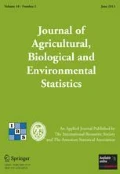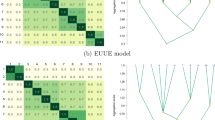Abstract
We demonstrate the potential of conditionally Gaussian state-space models in integrated population modeling, when certain model parameters may be functions of previous observations. The approach is applied to a heron census, and the data are best described by a model with three population-size thresholds which determine the population productivity. The model provides an explanation of how the population rebounds rapidly after major falls in size, which are characteristic of the data. By contrast, a simple logarithmic regression of productivity on population size was not significant. The results are of ecological interest, and suggest hypotheses for further investigation. Supplementary figures are available online.
Similar content being viewed by others
References
Abadi, F., Gimenez, O., Arlettaz, R., and Schaub, M. (2012), “Estimating the Strength of Density-Dependence in the Presence of Observation Errors Using Integrated Population Models”, submitted for publication.
Besbeas, P., and Morgan, B. J. T. (2012), “Kalman Filter Initialization for Integrated Population Modelling”, to appear in Applied Statistics.
Besbeas, P., Freeman, S. N., Morgan, B. J. T., and Catchpole, E. A. (2002), “Integrating Mark-Recapture-Recovery and Census Data to Estimate Animal Abundance and Demographic Parameters,” Biometrics, 58, 540–547.
Besbeas, P., Lebreton, J.-D., and Morgan, B. J. T. (2003), “The Efficient Integration of Abundance and Demographic Data,” Applied Statistics, 52, 95–102.
Besbeas, P., Freeman, S. N., and Morgan, B. J. T. (2005), “The Potential of Integrated Population Modelling,” Australian & New Zealand Journal of Statistics, 47, 35–48.
Besbeas, P., Borysiewicz, R., and Morgan, B. J. T. (2009), “Completing the Ecological Jigsaw,” in Modelling Demographic Processes in Marked Populations. Environmental and Ecological Statistics Series, Vol. 3, eds. D. L. Thomson, E. G. Cooch, and M. J. Conroy, pp. 515–542.
Breslow, N. (1974), “Covariance Analysis of Censored Survival Data,” Biometrics, 30, 89–99.
Brooks, S. P., King, R., and Morgan, B. J. T. (2004), “A Bayesian Approach to Combining Animal Abundance and Demographic Data,” Animal Biodiversity and Conservation, 27, 515–529.
Buckland, S. T., Newman, K. B., Thomas, L., and Koesters, N. B. (2004), “State-Space Models for the Dynamics of Wild Animal Populations,” Ecological Modelling, 171, 157–175.
Crick, H. Q. P. (2004), “The Impact of Climate Change on Birds,” Ibis, 146 (Suppl. 1), 48–56.
Dennis, B., Ponciano, J. M., Lele, S. R., Taper, M. L., and Staples, D. F. (2006), “Estimating Density Dependence, Process Noise, and Observation Error,” Ecological Monographs, 76, 323–341.
de Valpine, P. (2002), “Review of Methods for Fitting Time-Series Models With Process and Observation Error and Likelihood Calculations for Nonlinear, Non-Gaussian State-Space Models,” Bulletin of Marine Science, 70, 455–471.
de Valpine, P., and Hastings, A. (2002), “Fitting Population Models Incorporating Process Noise and Observation Error,” Ecological Monographs, 72, 57–76.
de Valpine, P., and Hilborn, R. (2005), “State-Space Likelihoods for Nonlinear Fisheries Time-Series,” Canadian Journal of Fisheries and Aquatic Sciences, 62, 1937–1952.
Ennola, K., Sarvala, J., and Devai, G. (1998), “Modelling Zooplankton Population Dynamics With the Extended Kalman Filtering Technique,” Ecological Modelling, 110, 135–149.
Freckleton, R. P., Watkinson, A. R., Green, R. E., and Sutherland, W. J. (2006), “Census Error and the Detection of Density Dependence,” Journal of Animal Ecology, 75, 837–851.
Freeman, S. N., and Morgan, B. J. T. (1992), “A Modelling Strategy for Recovery Data From Birds Ringed as Nestlings,” Biometrics, 48, 217–236.
Gimenez, O., Barbraud, C., Crainiceanu, C., Jenouvrier, S., and Morgan, B. J. T. (2006), “Semiparametric Regression in Capture-Recapture Modelling,” Biometrics, 62, 691–698.
Grenfell, B. T., Wilson, K., Finkenstädt, B. F., Coulson, T. N., Murray, S., Albon, S. D., Pemberton, J. M., Clutton-Brock, T. H., and Crawley, M. J. (1998), “Noise and Determinism in Synchronised Sheep Dynamics,” Nature, 394, 675–677.
Grosbois, V., Harris, M. P., Anker-Nilssen, T., McCleery, R. H., Shaw, D. N., Morgan, B. J. T., and Gimenez, O. (2009), “Survival at Multi-Population Scales Using Mark-Recapture Data,” Ecology, 90, 2922–2932.
Harvey, A. C. (1989), Forecasting, Structural Time Series Models and the Kalman Filter, Cambridge: Cambridge University Press.
Kitagawa, G. (1987), “Non-Gaussian State-Space Modeling of Nonstationary Time Series,” Journal of the American Statistical Association, 82, 1032–1063.
Knape, J. (2008), “Estimability of Density Dependence in Models of Time Series Data,” Ecology, 89, 2994–3000.
Marchant, J. H., Freeman, S. N., Crick, H. P. Q., and Beaven, L. P. (2004), “The BTO Heronries Census of England and Wales 1928–2000: New Indices and a Comparison of Analytical Methods,” Ibis, 146, 323–334.
Meyer, R., and Millar, R. B. (1999), “BUGS in Bayesian Stock Assessments,” Canadian Journal of Fisheries and Aquatic Sciences, 56, 1078–1086.
Millar, R. B., and Meyer, R. (2000), “Non-Linear State Space Modelling of Fisheries Biomass Dynamics by Using Metropolis–Hastings Within-Gibbs Sampling,” Applied Statistics, 49, 327–342.
North, P. M., and Morgan, B. J. T. (1979), “Modelling Heron Survival Using Weather Data,” Biometrics, 35, 667–682.
Schnute, J. (1994), “A General Framework for Developing Sequential Fisheries Models,” Canadian Journal of Fisheries and Aquatic Sciences, 51, 1676–1688.
Stenseth, N. C., Chan, K.-S., Tavecchia, G., Coulson, T., Mysterud, A., Clutton-Brock, T., and Grenfell, B. (2004), “Modelling Non-Additive and Nonlinear Signals From Climatic Noise in Ecological Time Series: Soay Sheep as an Example,” Proceedings of the Royal Society of London. Series B, 271, 1985–1993.
Tavecchia, G., Besbeas, P., Coulson, T., Morgan, B. J. T., and Clutton-Brock, T. H. (2009), “Estimating Population Size and Hidden Demographic Parameters With State-Space Modelling,” The American Naturalist, 173, 722–733.
Thomas, L., Buckland, S. T., Newman, K. B., and Harwood, J. (2004), “A Unified Framework for Modelling Wildlife Population Dynamics,” Australian & New Zealand Journal of Statistics, 47, 19–34.
Author information
Authors and Affiliations
Corresponding author
Electronic Supplementary Material
Below is the link to the electronic supplementary material.
Rights and permissions
About this article
Cite this article
Besbeas, P., Morgan, B.J.T. A Threshold Model for Heron Productivity. JABES 17, 128–141 (2012). https://doi.org/10.1007/s13253-011-0080-8
Published:
Issue Date:
DOI: https://doi.org/10.1007/s13253-011-0080-8




